 |
| Category: WW1/Light
Horse |

|
|
|
|
|
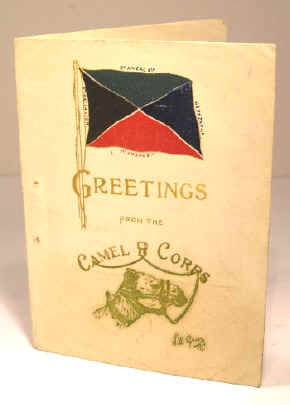 |
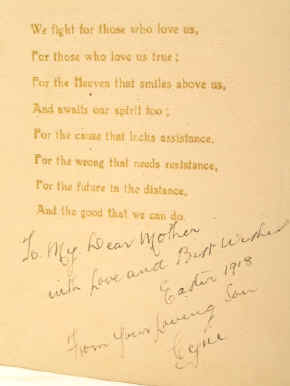 |
|
1918 Post Card fro an
AIF soldier in the Camel Corps |
|
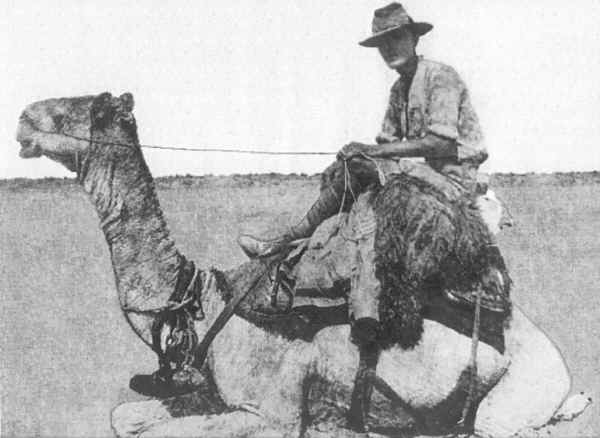
|
Sinai 1916. Sgt
Frederick Mercier - Imperial Camel Corps - 1st Camel Battalion
[1st Company]. The original of this photo was badly damaged by the
125 degree heat of the Dead Sea/Jordan Valley - digital
restoration took 3months! (Donor J. Van Luyn)
|
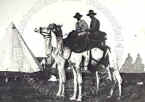 |
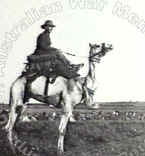 |
 |
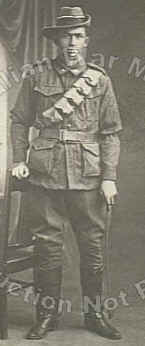
2028 Sergeant Peter Keiren Foster, 1st
Camel Corps (Late 7th Light Horse), Killed In Action 1917-01-09. |
| Surafend,
Palestine. 1918-07. Lieutenants Smyth And
Holland Mounted On Camels Near Tent Lines. Both Men Had Been Serving
With 1st Battalion, Imperial Camel Corps, Which Became The 14th
Australian Light Horse Regiment (14ALHR). (Donor Captain J.D.
Cramb) |
Surafend,
Palestine. 1918-07.
Captain J.D. Cramb, 14th
Australian Light Horse Regiment (14ALHR), Mounted On A Camel. (Donor
Captain J.D. Cramb) |
Palestine.
c.1917-05. Damaged carriages and railway
line blown up by the Camel Brigade and C Squadron, 11th Australian Light
Horse Regiment (11ALHR), who spent four days on a demolition raid to
destroy the railway line running south from Beersheba to Ashluj and Auja.
(Donor N. MacDonald) |
|
Timothy
Hogg was a bold Camelier
From the land of the setting sun;
And the girls gave Timmy a rousing
cheer
When he started to mop up the Hun.
He
trekked over Egypt and Sinai;
He led the Jacko’s a dance,
And he gleefully cried, as he
winked his eye:
“I’m lucky I’m not in
France.”
When Abdul came with a mighty
charge,
And Romani was fought and won,
Tim stopped some shrapnel, good and
large;
For a while his work was done.
They
packed him of with his blood soaked gear
In a ricketty ambulance;
But the driver laughed, as the
shells dropped near:
“We’re lucky we’re not in
France.”
At Rafa and Maghdaba, Timothy
fought,
Got a holiday wound as well
“It’s not such a joke as the
home folk thought
For Jacko can fight like hell.”
He
opened his mail in careless glee,
Then swore, and looked askance.
Said his “bint” and his Ma, and
his sisters three:
“You’re lucky you’re not in
France.
At Gaza’s heights the Light Horse
dashed,
Our Cameliers charged in vain:
The Welsh were slaughtered, Scots
were smashed;
In the Wadi blood flowed like rain.
Then
Tim heard an officer – who at Mons
Had stemmed the Huns’ advance-
Exclaim, amid the roar of the
murdering guns,
“I wish I was back in France”
by
“Trooper Bluegum” (Oliver Hogue)
|
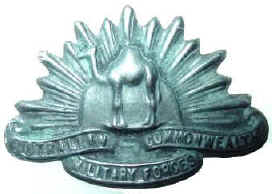
An unofficial
Rising Sun badge for the Camel Corps.
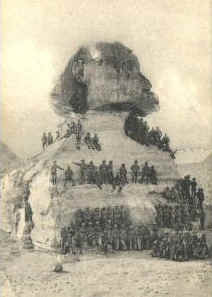
Aussies on the Sphinx
1915
|
Camel
Regiments
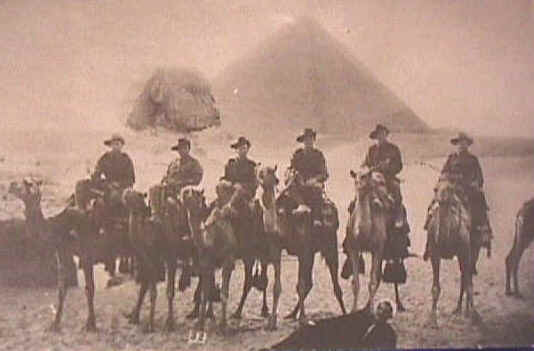
 1st
Camel Regiment 1st
Camel Regiment
Formed Egypt September 1916 by redesignation of
11th
Light Horse Regiment. Resumed its old identity in February 1917.
Sinai
 2nd
Camel Regiment
2nd
Camel Regiment
Formed Egypt September 1916 by redesignation of
12th
Light Horse Regiment. Resumed its old identity in February 1917.
Sinai
 3rd
Camel Regiment
3rd
Camel Regiment
Formed Egypt 24 December 1916 from
4th
Light Horse Regiment. Resumed its old identity in February 1917.
Sinai
4th Camel Regiment
Formed Egypt 10 November 1916 from 1st
Light Horse Double Squadron and 2nd
Light Horse Double Squadron. Broken up to form 17th
and 18th Camel Companies 3 February
1917.
Egypt
Camel
Battalions
The camel company (see below) was ideally suited for
action in the Western Desert but was found to be too small for combat
against the Turks in Palestine. Accordingly, camel companies were formed
into camel battalions in December 1916. In turn these were formed into
the 1st Imperial Camel Corps Brigade, which included 10
Australian, 6 British and 2 New Zealand Companies. Although formed from
all states, all camel reinforcements came from New South Wales.
Camel
Companies
In January 1916 the Imperial Camel Corps was formed from the infantry
brigades of the AIF to defend the Western Frontier of Egypt from the
Senussi rebels . Many of the men who volunteered for service with
camels, especially in the Western Australian units, had years of
experience with them. Four companies were initially formed and demand
was so great that five more were formed in June 1916 from surplus light
horse reinforcements.
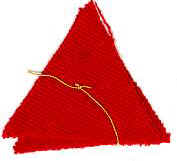 |
Felt shoulder patch set, unused,
of the 1st Camel Battalion |
 1st
Camel Battalion [1st Imperial Camel Corps Brigade] 1st
Camel Battalion [1st Imperial Camel Corps Brigade]
Formed Sinai 2 August 1916 from 5th (British), 6th (British), 7th
(British) and 4th Camel Companies.
Comprised of 4th, 6th (British), 7th
(British) and 12th Camel Companies at Maghdhaba, 1st, 3rd, 4th and 15th (New Zealand) Camel
Companies at Rafa. 2nd Camel Company
assigned 10 March 1917, replacing the 15th. Thereafter of 1st, 2nd,
3rd, 4th Camel Companies. Disbanded 25 July
1918. Personnel used to form 14th
Light Horse Regiment.
Palestine
 1st
Camel Company [1st Camel Battalion] 1st
Camel Company [1st Camel Battalion]
Formed Egypt 24 January 1916 from the 4th and 8th Infantry Brigades.
Assigned to 1st Camel Battalion 16 December 1916. Disbanded 25 July
1918. Personnel used to form 14th
Light Horse Regiment.
Egypt, Western Desert, Sinai, Palestine
 2nd
Camel Company [1st Camel Battalion] 2nd
Camel Company [1st Camel Battalion]
Formed Egypt 30 January 1916 from the 1st and 2nd Infantry Brigades.
Assigned to 1st Camel Battalion 10 March 1917. Disbanded 25 July 1918.
Personnel used to form 14th Light
Horse Regiment.
Egypt, Western Desert, Sinai, Palestine
 3rd
Camel Company [1st Camel Battalion] 3rd
Camel Company [1st Camel Battalion]
Formed Egypt 31 January 1916 from the 3rd and 7th Infantry Brigades.
Assigned to 1st Camel Battalion 16 December 1916. Disbanded 25 July
1918. Personnel used to form 14th
Light Horse Regiment.
Egypt, Western Desert, Sinai, Palestine
 4th
Camel Company
[1st Camel Battalion] 4th
Camel Company
[1st Camel Battalion]
Formed Egypt 31 January 1916 from the 4th and 8th Infantry Brigades.
Assigned to 1st Camel Battalion 16 December 1916. Disbanded 25 July
1918. Personnel used to form 14th
Light Horse Regiment.
Egypt, Western Desert, Sinai, Palestine
 3rd
Camel Battalion [1st Imperial Camel Corps Brigade] 3rd
Camel Battalion [1st Imperial Camel Corps Brigade]
Formed Sinai 4 December 1916 from 1st, 11th
and 15th (New Zealand) Camel Companies. Comprised of 11th, 12th and 14th
Camel Companies at Rafa. Thereafter from 11th, 12th, 14th
and 15th (New Zealand) Camel Companies. Disbanded 25 July 1918.
Australian personnel used to form 15th
Light Horse Regiment.
Palestine
 11th
Camel Company [3rd Camel Battalion] 11th
Camel Company [3rd Camel Battalion]
Formed Egypt 6 July1916 from Anzac Mounted Division. Disbanded 25
July 1918. Personnel used to form 15th
Light Horse Regimen..
Sinai, Palestine
 12th
Camel Company [3rd Camel Battalion] 12th
Camel Company [3rd Camel Battalion]
Formed Egypt 15 July 1916 from light horse reinforcements. Disbanded
25 July 1918. Personnel used to form 15th
Light Horse Regimen.
Sinai, Palestine
 13th
Camel Company [3rd Camel Battalion] 13th
Camel Company [3rd Camel Battalion]
Formed Egypt 25 July 1916 from light horse reinforcements. Disbanded
25 July 1918. Personnel used to form 15th
Light Horse Regiment.
Sinai, Palestine
 14th
Camel Company [3rd Camel Battalion] 14th
Camel Company [3rd Camel Battalion]
Formed Egypt 4 August 1916 from light horse reinforcements.
Disbanded 25 July 1918. Personnel used to form 15th
Light Horse Regiment.
Sinai, Palestine
 4th
(Anzac) Camel Battalion [1st Imperial Camel Corps
Brigade] 4th
(Anzac) Camel Battalion [1st Imperial Camel Corps
Brigade]
Formed Sinai 16 February 1917 from 16th (New Zealand), 13th, 17th and
18th
Camel Companies. Comprised of 14th (New Zealand), 15th (New
Zealand),. 17th and 18th
Camel Companies. Disbanded 25 July 1918.
Palestine
 17th
Camel Company [4th (Anzac)
Camel Battalion] 17th
Camel Company [4th (Anzac)
Camel Battalion]
Formed Egypt 3 February 1917 from 4th
Camel Regiment. Disbanded July 1918.
Palestine
 18th
Camel Company [4th (Anzac)
Camel Battalion] 18th
Camel Company [4th (Anzac)
Camel Battalion]
Formed Egypt 3 February 1917 from 4th
Camel Regiment. Disbanded July 1918.
Palestine
Camel Unit Reinforcements
-
Departed
-
Sydney on
Morea
27 May 1916,
-
Sydney on
Mongolia
8 July1916,
-
Sydney on
Malwa
22 July 1916,
-
Sydney on
Mooltan
19 August 1916,
-
Sydney on
Barunga
20 October 1916,
-
Melbourne on
Vestalia
15 December 1916,
-
Melbourne on
Barunga
10 May 1917,
-
Sydney on
Karmala
3 February 1917,
-
Melbourne on
Karmala
6 February 1917,
-
Sydney on
Morea
17 February 1917,
-
Melbourne on
Morea
20 February 1917,
-
Sydney on
Port Sydney on 9 May 1917,
-
Fremantle on
Boorara
22 May 1917,
-
Fremantle on
Port
Lincoln 30 June 1917,
-
Sydney on
Kyarra
3 September 1917,
-
Fremantle on
Kyarra
17 September 1917,
-
Fremantle on
Commonwealth
9 November 1917,
-
Sydney on
Canberra
16 November 1917,
-
Sydney on
Port
Darwin 30 April 1918.
most details from Ross Mallett's site http://www.unsw.adfa.edu.au/~rmallett/index.html |
Imperial Camel Corps
The Imperial Camel Corps (ICC) was
formed in January 1916 in order to deal with the revolt of pro-Turkish
Senussi tribesmen in Egypt’s Western Desert. The first four companies
were recruited from Australian infantry battalions recuperating after
Gallipoli. Four battalions were eventually formed. The 1st and 3rd were
entirely Australian, the 2nd was British, and the 4th was a mix of
Australians and New Zealanders. The ICC also had its own machine gun
unit, and a battery of light artillery recruited in Hong Kong and
Singapore.
The operations of the ICC in the
Western Desert in 1916 were characterised by long patrols and brief
skirmishes with the Senussi. British commanders in Egypt appreciated the
fighting qualities of the ICC and in late 1916 the ICC was transferred
to the Sinai desert to take part in operations against the Turkish army.
Here the battalions of the ICC fought alongside Australian light horse
units at Romani, Magdhaba and Rafa.
The ICC remained an integral part of
the British and dominion force that advanced north through Palestine in
1917 and 1918. It suffered particularly heavily during the Second Battle
of Gaza on 19 April 1917, and in the operations conducted in November to
destroy the Turkish defensive line between Gaza and Beersheba. As the
ICC moved into the more fertile country of northern Palestine, its
practicality declined. The camels needed more fodder and water than
equivalent numbers of horses, and, unimpeded by the desert, horses could
move much faster. The bulk of the ICC was disbanded in June 1918 and the
Australians were used to form the 14th and 15th Light Horse Regiments.
The men of the ICC had a rough
reputation, largely because when the Corps was originally formed
Australian battalion commanders had seized upon it as an opportunity to
offload some of their more difficult characters. In 1917 a British
supply dump at Rafa was warned to double their guards as the ICC was
going to be camped nearby. The men of the ICC were, however, resourceful
and effective. While defending a hill called Musallabeh in April 1918,
some Australians of the ICC ran out of hand grenades. They resorted to
heaving boulders down upon the attacking Turks and eventually fought
them off. The hill became known as the “Camel’s Hump”. Text from
AWM
- 200 killed, 598 wounded
-
Decorations Australian ICC
personnel only
- 18 MC, 2 bars
- 13 DCM
- 26 MM
- 2 MSM
- 43 MID
- 9 foreign awards
|
|










 1st
Camel Regiment
1st
Camel Regiment

